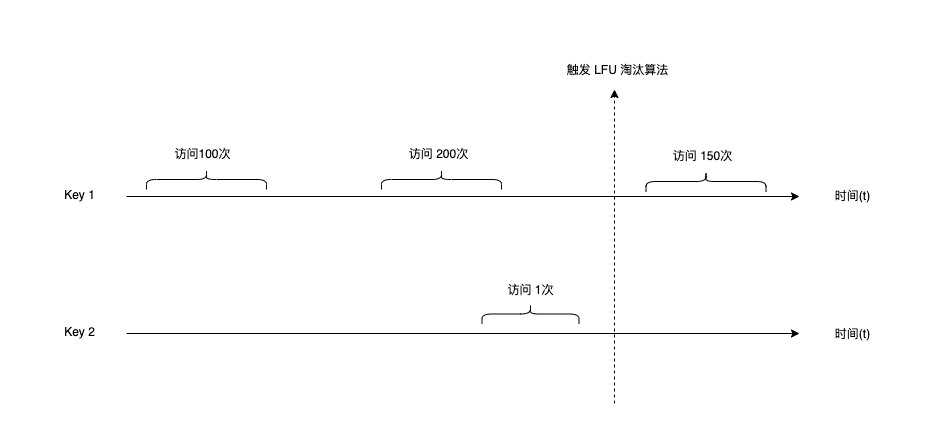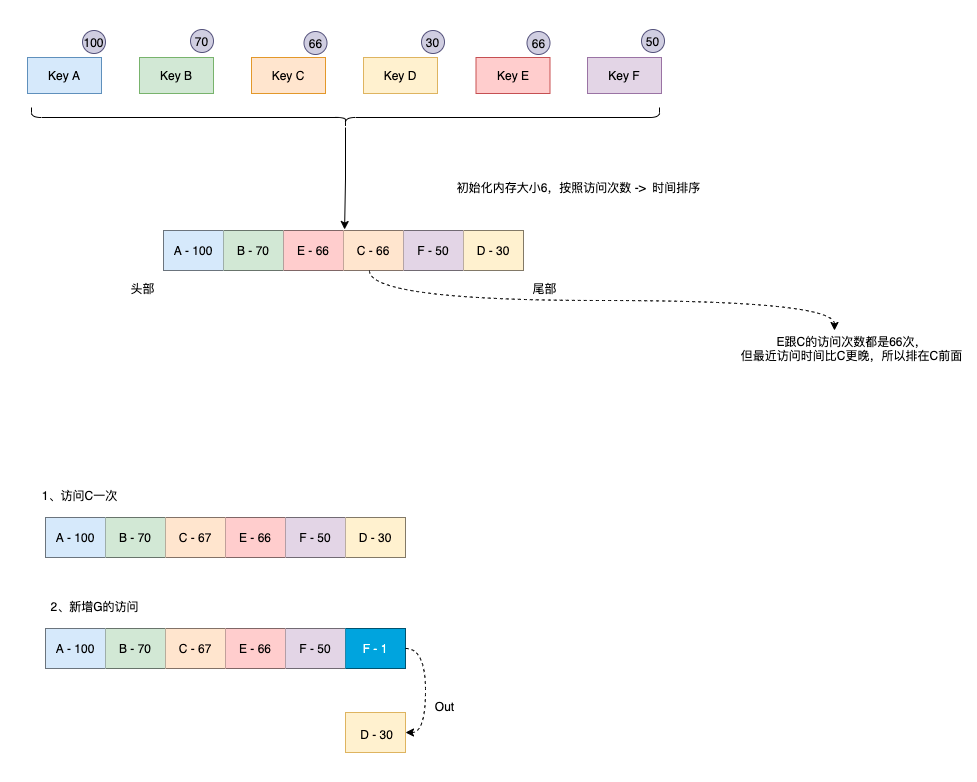Redis系列20:LFU記憶體淘汰演演算法分析
Redis系列1:深刻理解高效能Redis的本質
Redis系列2:資料持久化提高可用性
Redis系列3:高可用之主從架構
Redis系列4:高可用之Sentinel(哨兵模式)
Redis系列5:深入分析Cluster 叢集模式
追求效能極致:Redis6.0的多執行緒模型
追求效能極致:使用者端快取帶來的革命
Redis系列8:Bitmap實現億萬級資料計算
Redis系列9:Geo 型別賦能億級地圖位置計算
Redis系列10:HyperLogLog實現海量資料基數統計
Redis系列11:記憶體淘汰策略
Redis系列12:Redis 的事務機制
Redis系列13:分散式鎖實現
Redis系列14:使用List實現訊息佇列
Redis系列15:使用Stream實現訊息佇列
Redis系列16:聊聊布隆過濾器(原理篇)
Redis系列17:聊聊布隆過濾器(實踐篇)
Redis系列18:過期資料的刪除策略
Redis系列19:LRU記憶體淘汰演演算法分析
1 介紹
上一期我們介紹了 Redis系列19:LRU淘汰記憶體淘汰演演算法分析 ,大致瞭解了LRU(Least Rencently Used) 的演演算法原理,即將最近最久未使用的演演算法進行資料淘汰。
但是這樣的演演算法也有一些比較明顯缺陷:
- 穩定性和效能問題:LRU演演算法認為最近最少使用的資料是最該被淘汰的,但是這可能導致某些資料被頻繁地淘汰和載入,因為它們可能只在某個時間段內被使用一次,而在其他時間段內則不會被使用。這會使得快取的效率降低,增加了CPU和記憶體之間的通訊開銷。
- 空間問題:LRU演演算法需要維護一個連結串列來記錄資料的存取順序,這需要額外的空間。連結串列可能會佔用較大的空間,導致快取的效率降低。
- 存取順序問題:我們的存取順序並不一定是按照時間來的,而是有一定的規律。例如,我們在處理資料時可能會按照某個頻率存取資料,而不是按照時間順序。這種情況下,LRU演演算法可能會將某些我們還需要被存取資料淘汰掉。
- 資料侷限性問題:淘汰演演算法的本意是保留那些將來最有可能被再次存取的資料,而LRU演演算法只是預測最近被存取的資料將來最有可能被存取到。這樣太侷限,誤傷很多高頻被存取但某段時間空窗的資料。

如上圖,Key 1會被優先淘汰掉,但實際上,Key 1的存取頻率和可能行高很多,我們並不希望Key 1被淘汰,而是希望淘汰率是 Key 2 > Key 1
為了解決這些問題,一些改進的演演算法被提出來,例如LFU(Least Frequently Used)演演算法和FIFO(First In First Out)演演算法。這些演演算法在某些情況下比LRU演演算法更合理更有效。
2 實現原理
LFU(Least Frequently Used)是Redis 4.0 引入的淘汰演演算法,它通過key的存取頻率、存取時間比較來淘汰key,重點突出的是Frequently Used,用於在快取容量有限時決定哪些快取塊應該被清除。
LFU演演算法根據快取塊的使用頻率來決定哪些塊應該被清除。具體來說,它會記錄每個快取塊的使用次數,並按照使用次數從低到高排序。當快取達到容量上限時,LFU演演算法會選擇使用次數最少的快取塊進行清除,也就是最不經常使用的快取塊。
LFU演演算法的優點是能夠有效地防止快取溢位,並且能夠最大限度地減少清除重要資料的概率。但是,由於需要記錄每個快取塊的使用次數,因此LFU演演算法需要較大的記憶體空間,並且由於需要經常更新使用次數,因此其時間複雜度相對較高。
LFU演演算法常用於Web快取、資料庫快取、檔案系統快取等場景,用於提高系統的效能和穩定性。
實現原理如下:

LFU近似於LRU,使用概率計數器Morris計數器來估計每個物件的存取頻率,並結合衰變週期使計數器隨時間減少。這樣,即使在過去,我們也不再考慮頻繁存取的金鑰。因此,該演演算法可以適應存取模式的變化。
Redis4.0之後 maxmemory_policy 淘汰策略 新增了兩個LFU模式:
- allkeys-lfu:對全部key採用LFU淘汰演演算法進行計算
- volatile-lfu:對設定了過期時間的key採用LFU淘汰演演算法
3 演演算法實現
3.1 從原始碼理解演演算法實現過程
在LFU模式下,Redis物件頭的24bit lru欄位被分成兩段來儲存。其中,高16bit用於儲存最後一次計數器降低的時間(ldt),低8bit用於儲存存取次數的對數值(logc)。
-
高16bit的ldt欄位用於記錄最近一次計數器降低的時間。由於只有16bit,它可以表示的最大值為65535(2^16-1)。由於時間以1秒為單位進行計數,因此大約每45.5天(65535/24/60)時間戳會折返重新從0開始。
-
低8bit的logc欄位用於記錄存取次數的對數值。由於只有8bit,它可以表示的最大值為255。實際上,logc無法記錄真實的Redis key的存取次數,因為每個新加入的key的logc初始值為5(LFU_INITI_VAL),這樣可以保證新加入的值不會被首先選中淘汰。每次存取key時,logc都會更新。
16 bits 8 bits
+----------------+--------+
+ Last decr time | LOG_C |
+----------------+--------+

- Last Decrement Time計算的演演算法原始碼:
/* Return the current time in minutes, just taking the least significant
* 16 bits. The returned time is suitable to be stored as LDT (last decrement
* time) for the LFU implementation. */
// server.unixtime為Redis快取的Unix時間戳
// 使用的Unix的分鐘時間戳,取模2^16
unsigned long LFUGetTimeInMinutes(void) {
return (server.unixtime/60) & 65535;
}
/* Given an object last access time, compute the minimum number of minutes
* that elapsed since the last access. Handle overflow (ldt greater than
* the current 16 bits minutes time) considering the time as wrapping
* exactly once. */
unsigned long LFUTimeElapsed(unsigned long ldt) {
// 獲取系統當前的LFU time
unsigned long now = LFUGetTimeInMinutes();
// 如果now >= ldt 直接取差值
if (now >= ldt) return now-ldt;
// 如果now < ldt 增加上65535
return 65535-ldt+now;
}
- Redis Logistic Counter增長計算的原始碼:
/* Logarithmically increment a counter. The greater is the current counter value
* the less likely is that it gets really implemented. Saturate it at 255. */
uint8_t LFULogIncr(uint8_t counter) {
// Logistic Counter最大值為255 (8位元的最大值), 如果已經是最大值了,直接返回
if (counter == 255) return 255;
// 取一個0~1之間的亂數數
double r = (double)rand()/RAND_MAX;
// counter減去LFU_INIT_VAL (LFU_INIT_VAL為每個key的Logistic Counter基數值,預設為5)
double baseval = counter - LFU_INIT_VAL;
// 如果衰減之後counter已經小於基數(如5),那麼得出的結果 < 0,也取0
if (baseval < 0) baseval = 0;
// 可以看出如果lfu_log_factor的值越大,分母越大,得到的p越小
double p = 1.0/(baseval*server.lfu_log_factor+1);
// p 越小,r < p的可能性就越小,Logistic Counter增加的概率就越小
// 綜上,lfu_log_factor越大增長越緩慢,緩解255空間緊張的問題
if (r < p) counter++;
return counter;
}
3.2 在redis.conf中開啟設定
可以修改redis.conf組態檔,設定maxmemory-policy volatile-lfu / allkeys-lfu 來進行開啟
# MAXMEMORY POLICY: how Redis will select what to remove when maxmemory
# is reached. You can select one from the following behaviors:
#
# volatile-lru -> Evict using approximated LRU, only keys with an expire set.
# allkeys-lru -> Evict any key using approximated LRU.
# volatile-lfu -> Evict using approximated LFU, only keys with an expire set.
# allkeys-lfu -> Evict any key using approximated LFU.
# volatile-random -> Remove a random key having an expire set.
# allkeys-random -> Remove a random key, any key.
# volatile-ttl -> Remove the key with the nearest expire time (minor TTL)
# noeviction -> Don't evict anything, just return an error on write operations.
#
# LRU means Least Recently Used
# LFU means Least Frequently Used
#
# Both LRU, LFU and volatile-ttl are implemented using approximated
# randomized algorithms.
#
# Note: with any of the above policies, when there are no suitable keys for
# eviction, Redis will return an error on write operations that require
# more memory. These are usually commands that create new keys, add data or
# modify existing keys. A few examples are: SET, INCR, HSET, LPUSH, SUNIONSTORE,
# SORT (due to the STORE argument), and EXEC (if the transaction includes any
# command that requires memory).
#
# The default is:
#
# maxmemory-policy noeviction
#
#
# 備註1:對設定了過期時間的key啟用LFU淘汰演演算法
# maxmemory-policy volatile-lfu
# 備註2:對全部key啟用LFU淘汰演演算法進行計算
# maxmemory-policy allkeys-lfu
4 總結
LFU(Least Frequently Used)是Redis 4.0 引入的淘汰演演算法,它通過key的存取頻率、存取時間比較來淘汰key,重點突出的是Frequently Used,用於在快取容量有限時決定哪些快取塊應該被清除。它避免了LRU淘汰演演算法明顯缺陷。
